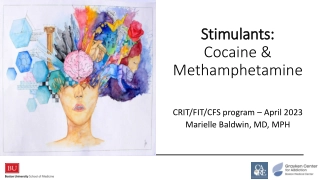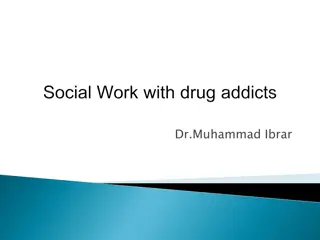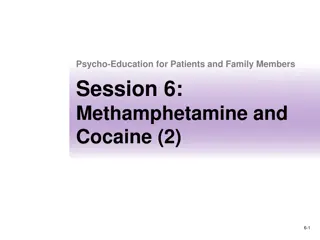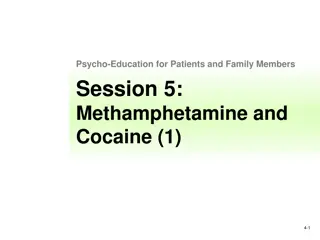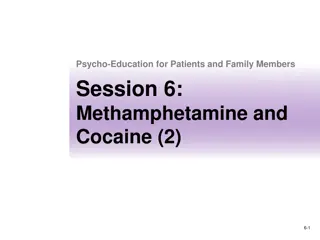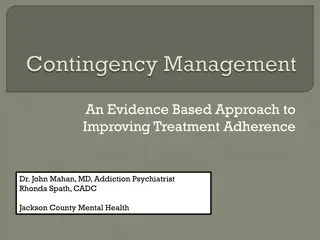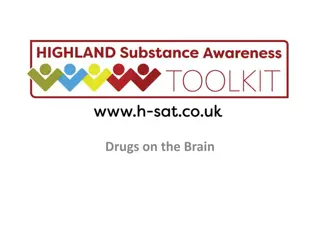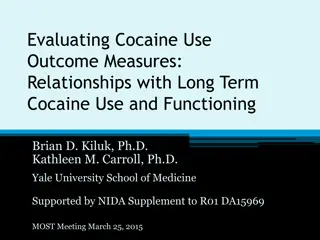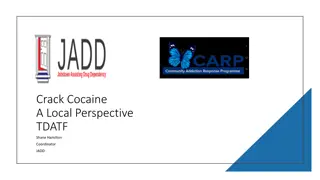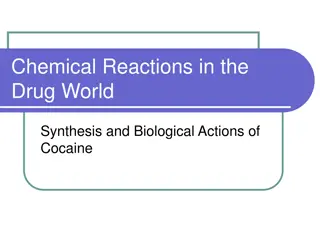Understanding the Effects of Methamphetamine and Cocaine
Explore the key differences between cocaine and methamphetamine, how dopamine plays a crucial role in the brain affecting movement, thinking, and pleasure responses. Learn about the effects of dopamine imbalance and the impact of stimulant drugs on dopamine levels over time. Understand the addiction cycle and the various routes of administration for these substances.
Download Presentation

Please find below an Image/Link to download the presentation.
The content on the website is provided AS IS for your information and personal use only. It may not be sold, licensed, or shared on other websites without obtaining consent from the author. Download presentation by click this link. If you encounter any issues during the download, it is possible that the publisher has removed the file from their server.
E N D
Presentation Transcript
Psycho-Education for Patients and Family Members Session 5: Methamphetamine and Cocaine (1) 4-1
Differences Between Cocaine and Methamphetamine Cocaine effects: 1 to 2 hours. Methamphetamine effects: 8 to 12 hours. 4-2
Dopamine Is a chemical that is always present in the brain Plays an important role in - Body movement - Thinking - Motivation and reward - Pleasure responses 4-3
Example of Dopamines Effect Eating Dopamine Pleasure Motivation (desire) to eat again when hungry 4-4
Dopamine Imbalance Too much dopamine causes nervousness, irritability, aggressiveness, paranoia, and bizarre thoughts. Too little dopamine causes low mood, fatigue, tremors, and problems with muscle control. 4-5
Dopamine and Stimulant Drugs Shabu/cocaine Use Dopamine Mostly Pleasure + Some Negative Effects 4-6
Dopamine and Stimulant Use Over Time Damaged dopamine system Shabu/cocaine Use Over Time Some Pleasure + Many Negative Effects 4-7
Craving Use Depression Addiction Cycle 4-8
Route of Administration Available forms of Shabu/cocaine: Injected Smoked Snorted How a drug is taken influences: How quickly it produces an effect The strength of the drug s effects, both positive and negative The kind of negative effects a person will experience 4-9
Popularity of Shabu Shabu users in 2015 were 0.86 million or 1.1% of the population aged 10-69 years. 96% of the patients admitted to the DOH- TRCs were Shabu users in 2017. 4-11
Question: What are some of the immediate effects of Shabu? To your feelings and mental status To your body 1-12
Immediate Psychological Effects Increased euphoria Increased alertness or wakefulness Increased feelings of strength/energy Increased feelings of invulnerability Increased feelings of confidence/competence Increased feelings of sexual desire Decreased boredom, loneliness, and shyness 4-13
Immediate Physical Effects Increase of: Heart rate Blood pressure Pupil size Breathing rate Sound sensitivity Body temperature Decrease of: Appetite Sleep Reaction time 4-14
Toxic Effects Methamphetamine can cause serious psychological and physical damage. Negative effects begin fairly soon. 4-15
Question: What are some of the chronic or long-term effects of Shabu? To your feelings and mental status To your body 1-16
Chronic Psychological Effects Confusion Loss of ability to concentrate and organize information Loss of ability to feel pleasure without the drug Paranoia Insomnia and fatigue Mood swings Irritability and anger Depression Anxiety and panic disorder Reckless, unprotected sexual behavior 4-17
Severe Psychological Effects Hallucinations Severe depression that can lead to suicidal thoughts or attempts Episodes of sudden, violent behavior Severe memory loss that may be permanent 4-18
Chronic Physical Effects Tremor Weakness Dry mouth Weight loss/malnutrition Increased sweating Oily skin Sores Headaches Severe problems with teeth and gums 4-19
Severe Physical Effects Seizures Damaged blood vessels in the brain/stroke Damaged brain cells Irregular heartbeat/sudden death Heart attack or chronic heart problems Kidney failure Liver failure Tweaking Infected skin sores 4-20


